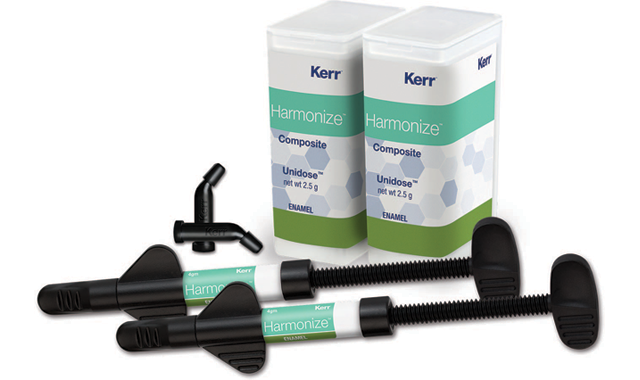I Use That: Kerr Harmonize
One doctor’s take on the benefits of this universal composite with Adaptive Response Technology.

In the past, Dr. Joyce Bassett felt like she had to compromise between strength and esthetics when placing composite in the anterior. Kerr Harmonize, a universal composite with Adaptive Response Technology, enables her to place restorations anywhere in the mouth with confidence.
What Dr. Joyce Bassett says about Kerr Harmonize universal composite:
Before Harmonize, I would use a stronger composite on the lingual surface of the tooth, then I would use an esthetic, high polishable microfill composite that was weaker for the final facial layer. I don’t have to do that anymore. Harmonize is not only strong, but it blends in with the surrounding enamel really well. The composite just disappears. You can’t see where the restoration ends and the tooth begins. It’s strong and it’s beautiful, so you can use it in both the anterior and the posterior. I feel confident using this material in load-bearing areas and in areas that demand visual imperceptibility.
Related reading: 5 ways composite advances can change your workflow
With Harmonize, Kerr changed the nanoparticle filler network, so it now has silica and zirconia. The nanoparticles form together, which is what makes the material so much stronger. Harmonize is the strongest universal composite Kerr has ever offered. So if you want a strong composite in the back of the mouth, you can use Harmonize for traditional incremental layering. I prefer bulk fill in the posterior, but if you choose to cap the last 1 to 2 mm over a bulk fill, this composite is my choice because it is both esthetic and strong and it polishes amazingly well. Basically, you can use Harmonize everywhere.
Before, I felt like I had to compromise between strength and esthetics, but Harmonize was designed to meet this demand. The universal composite has clinical performance in strength, handling and optical properties. Harmonize isn’t sticky; it’s easy to handle and has great scluptability. When I’m building a Class IV or Class V in the anterior, it does not slump and it stays wherever I put it.
Using Harmonize saves me time and makes my job easier, but the most important point is the fact that it’s imperceptible, which patients love. They don’t want to see the restoration. Many patients analyze their smiles with magnifying mirrors and they are disappointed if they can see the line where the restoration ends and the tooth begins.
I always say when you’re ready to buy a composite, do not buy the same composite if there is a newer generation. Always purchase the next generation. The manufacturers and scientists are always upping their game and idealizing and improving on their previous generation when creating their newest generation of composite, so it’s worth giving the newest generations a try.
I suggest you purchase a few of the most common shades you use, like B1E, A1E, XLE and XL2D, and get started. Your patients will love the results.
ACTIVA BioACTIVE Bulk Flow Marks Pulpdent’s First Major Product Release in 4 Years
December 12th 2024Next-generation bulk-fill dental restorative raises the standard of care for bulk-fill procedures by providing natural remineralization support, while also overcoming current bulk-fill limitations.